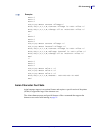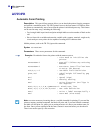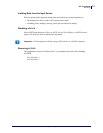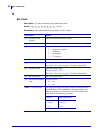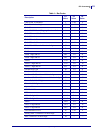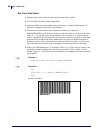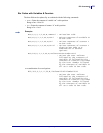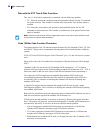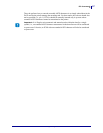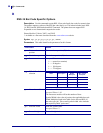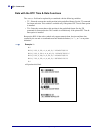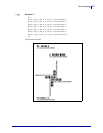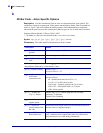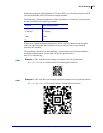
EPL Commands
B
56
14245L-003 Rev. A EPL Programming Guide 12/16/13
Data with the RTC Time & Date Functions
The “Data” field can be replaced by or combined with the following variables:
• TT = Prints the current time at this position in the predefined format. See the TT command
for format selection. This variable is available only if the printer Time & Date option is
installed.
• TD = Prints the current date at this position in the predefined format. See the TD
command for format selection. This variable is available only if the printer Time & Date
option is installed.
Code 128 Bar Code Function Characters
The printer supports Code 128 function control characters (FCN#). Multiple FCN#s, TTs, TDs
and “DATA” strings can be concatenated, allowing them to be inserted anywhere within the
symbol.
FCN2, FCN3 and FCN4 are illegal in Code 128 mode C (p4 = 1C) and will result in a syntax
error.
Please refer to the Code 128 standard for a description of function characters FNC1 through
FNC3.
“Standard” Code 128 can encode all 128 standard ASCII characters (0 – 127). Function
character FCN4 provides a means of also encoding extended ASCII characters (128 – 255). It
directs the reader to add 128 to the value of each affected character before transmitting it.
Two consecutive FCN4s toggle between standard and extended ASCII mode for all
succeeding data characters (until the end of the symbol, or until another pair of FCN4s is
encountered). This is referred to as latching into extended ASCII mode or latching into
standard ASCII mode.
A single FCN4 toggles between standard and extended ASCII mode for only a single
following data character. This is referred to as shifting into extended ASCII mode or shifting
into standard ASCII mode.
Both code sets A and B are needed to represent the entire extended ASCII character set, just as
both sets are needed to represent the standard ASCII character set.
FCN4s can be inserted manually, if necessary or desired, by following the syntax described
above. The printer will, however, insert them automatically if extended ASCII characters are
encountered in the DATA. It will do so in the most efficient manner possible:
• If up to 4 contiguous extended ASCII characters are encountered, it will shift into
extended ASCII mode by inserting a single FCN4 before each one;
• If 5 or more contiguous extended ASCII characters are encountered, it will latch into
extended ASCII mode by inserting two FCN4s before them.
• While latched into extended ASCII mode, it will apply the same rules if standard ASCII
characters are encountered.
Note • Some bar code formats will not support date names or the date or time delimiters used
by the printer to separate data parameters.




